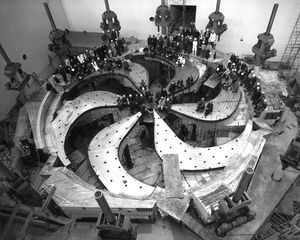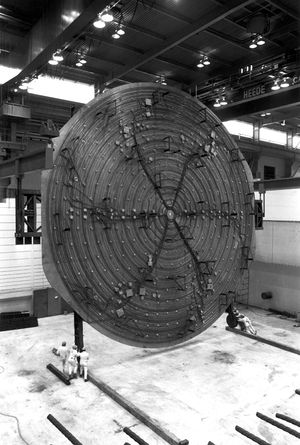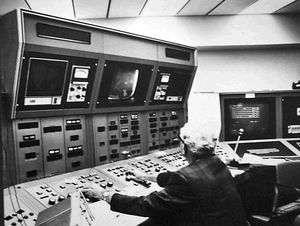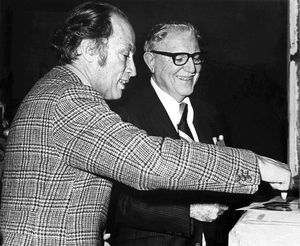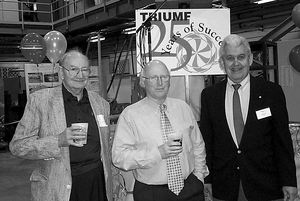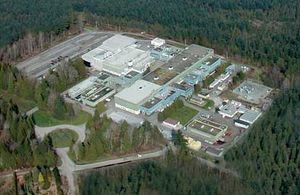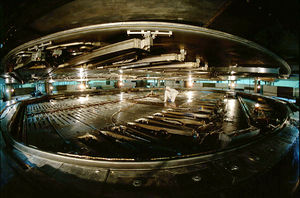Milestone-Nomination:First 500 MeV proton beam from the worlds largest cyclotron: Difference between revisions
Dmichelson (talk | contribs) No edit summary |
Dmichelson (talk | contribs) No edit summary |
||
| Line 54: | Line 54: | ||
The quality of the initial design and engineering and the significance of the result are underscored by the longevity of the TRIUMF cyclotron. Thirty-five years after the first 500 MeV proton beam was extracted, the cyclotron is still the main engine of TRIUMF’s world-leading research program which currently includes meson physics, nuclear physics, nuclear astrophysics, nuclear medicine and irradiation services for industry. | The quality of the initial design and engineering and the significance of the result are underscored by the longevity of the TRIUMF cyclotron. Thirty-five years after the first 500 MeV proton beam was extracted, the cyclotron is still the main engine of TRIUMF’s world-leading research program which currently includes meson physics, nuclear physics, nuclear astrophysics, nuclear medicine and irradiation services for industry. | ||
KAON | In the 1980s, TRIUMF proposed to use the 500 MeV cyclotron as an injector to complex of storage rings and synchrotrons (often referred to as the KAON Factory) that would raise the proton beam energy to 30 GeV and yield the most intense high energy proton beams in the world - about 100 times the particle flux of existing machines. Details are described in many publications, including | ||
M.K. Craddock, "The TRIUMF KAON Factory," in Proc. 1991 IEEE Particle Accelerator Conference,<br> 6-9 May 1991, pp. 57 - 61.<br> | |||
KAON is both the name of the high energy K-mesons that the accelerator complex would be able to make and an acronym that refers to the entire suite of particles that would have been produced, including K-mesons, Anti-protons, Other hadrons and Neutrinos. | |||
Although the KAON project was unable to secure the government investment required to proceed to full construction and was eventually shelved in the mid-1990's, the intense development effort prepared the TRIUMF Laboratory to take on other ambitious projects in the 1990's and 2000's. Foremost among these is ISAC (Isotope Separation and ACceleration), a facility in which a proton beam from the 500 MeV cyclotron is used to produce beams of exotic isotopes. These are further accelerated using linear accelerators. The complex allows researchers to study the properties and structure of these exotic isotopes. | |||
AAPS | TRIUMF is contributing the skills and knowledge that it has developed during the past forty years to the development of detectors and equipment used at other facilities including the ATLAS detector employed by the Large Hadron Collider (LHC) at CERN and the T2K (Tokai-to-Kamioka) neutrino oscillation experiment in Japan. TRIUMF, in partnership with MDS Nordion, uses proton beams from the main cyclotron and four smaller cyclotrons to produce radioisotopes for use in medical imaging and diagnostics. The recent decision to fund Advanced Applied Physics Solutions (AAPS) under the Canadian Centres of Excellence in Commercialization and Research program paves the way to further application of TRIUMF discoveries and methods in ways that directly benefit Canadians. | ||
== Distinguishing features or characteristics of this work == | == Distinguishing features or characteristics of this work == | ||
Revision as of 19:06, 5 February 2010
Docket Number: 2009-08
Proposal Link: https://ethw.org/Milestone-Proposal:First_500_MeV_proton_beam_from_the_worlds_largest_cyclotron
Proposed Citation
First 500 MeV Proton Beam from the World's Largest Cyclotron, 1974
At 3:30 pm on 15 December 1974, the first 500 MeV proton beam was extracted from the TRIUMF cyclotron. Since then, TRIUMF has used proton beams from its cyclotron (and secondary muon and pion beams produced in its experimental halls) to conduct pioneering studies that have advanced nuclear physics, particle physics, molecular and materials science, and nuclear medicine.
The plaque will be installed on a wall outside the cyclotron main control room near the site dedication plaque. (The first successful beam extraction was manually controlled from the main console in that room.)
Historical Photographs
(provided by the TRIUMF Laboratory)
Significance
The TRIUMF Laboratory
TRIUMF is Canada’s national laboratory for particle and nuclear physics. It is owned and operated as a joint venture by a consortium of Canadian universities. Its operations are supported by a contribution from the National Research Council Canada while capital funds for buildings are provided by the Government of British Columbia.
TRIUMF's mission is:
- To make discoveries that address the most compelling questions in particle physics, nuclear physics, nuclear medicine, and materials science;
- To act as Canada’s steward for the advancement of particle accelerators and detection technologies; and
- To transfer knowledge, train highly skilled personnel, and commercialize research for the economic, social, environmental, and health benefit of all Canadians.
An aerial photo of the TRIUMF Laboratory is shown below. More information concerning the TRIUMF Laboratory can be found at http://www.triumf.ca .
The 500 MeV Cyclotron
The heart of the TRIUMF Laboratory is the 500 MeV cyclotron that was conceived, designed, constructed and commissioned between 1965 and 1974. The events leading up to extraction of the first 500 MeV proton beam from the cyclotron are described in:
M.K. Craddock, "The First Beam - A Whirlwind Visual History - and Prehistory," Annual General Meeting of the TRIUMF Users’ Group, 13 December 1999.
Compared to the first and second generation of cyclotrons that provided much lower beam energies and intensities, the physical size of the 500 MeV cyclotron is truly impressive. The main magnet is 18 metres in diameter and weighs 4000 tons. The 23 MHz main RF amplifier delivers almost 1 million watts of power in order to develop 200 kV across the accelerating gap. The photo below was taken during a maintenance period with the lid of the cyclotron's vacuum tank raised. The lone figure in the centre of the photo gives a sense of scale.
The sheer scale of the design and construction effort required TRIUMF staff and contractors to develop revolutionary computer-assisted design, modelling, measurement and tuning technologies in an era dominated by mainframes and minicomputers. Some of these codes, e.g., RELAX3D - a Laplace and Poisson equation solver, are still in use today.
Because of its size, TRIUMF was one of the first particle accelerators to employ a software-based supervisory control and data acquisition system rather than direct linkage of cyclotron and beamline components to a hardware-based control panel.
By providing intermediate energy proton beams (i.e., beam energies greater than 100 MeV but less than 1 GeV) that are two orders of magnitude more intense than were previously available, the TRIUMF cyclotron (and its two sister meson factories in the United States and Europe) have revolutionized nuclear physics, particle physics, molecular and materials science, and nuclear medicine.
Subsequent Developments at the TRIUMF Laboratory
The quality of the initial design and engineering and the significance of the result are underscored by the longevity of the TRIUMF cyclotron. Thirty-five years after the first 500 MeV proton beam was extracted, the cyclotron is still the main engine of TRIUMF’s world-leading research program which currently includes meson physics, nuclear physics, nuclear astrophysics, nuclear medicine and irradiation services for industry.
In the 1980s, TRIUMF proposed to use the 500 MeV cyclotron as an injector to complex of storage rings and synchrotrons (often referred to as the KAON Factory) that would raise the proton beam energy to 30 GeV and yield the most intense high energy proton beams in the world - about 100 times the particle flux of existing machines. Details are described in many publications, including
M.K. Craddock, "The TRIUMF KAON Factory," in Proc. 1991 IEEE Particle Accelerator Conference,
6-9 May 1991, pp. 57 - 61.
KAON is both the name of the high energy K-mesons that the accelerator complex would be able to make and an acronym that refers to the entire suite of particles that would have been produced, including K-mesons, Anti-protons, Other hadrons and Neutrinos.
Although the KAON project was unable to secure the government investment required to proceed to full construction and was eventually shelved in the mid-1990's, the intense development effort prepared the TRIUMF Laboratory to take on other ambitious projects in the 1990's and 2000's. Foremost among these is ISAC (Isotope Separation and ACceleration), a facility in which a proton beam from the 500 MeV cyclotron is used to produce beams of exotic isotopes. These are further accelerated using linear accelerators. The complex allows researchers to study the properties and structure of these exotic isotopes.
TRIUMF is contributing the skills and knowledge that it has developed during the past forty years to the development of detectors and equipment used at other facilities including the ATLAS detector employed by the Large Hadron Collider (LHC) at CERN and the T2K (Tokai-to-Kamioka) neutrino oscillation experiment in Japan. TRIUMF, in partnership with MDS Nordion, uses proton beams from the main cyclotron and four smaller cyclotrons to produce radioisotopes for use in medical imaging and diagnostics. The recent decision to fund Advanced Applied Physics Solutions (AAPS) under the Canadian Centres of Excellence in Commercialization and Research program paves the way to further application of TRIUMF discoveries and methods in ways that directly benefit Canadians.
Distinguishing features or characteristics of this work
TRIUMF is the world's largest cyclotron, and one of only three intermediate-energy high-intensity accelerators in the world. The TRIUMF design team pioneered the production and acceleration of H- ions in order to simplify beam extraction and the use of an AVF (azimuthally varying field) main magnet to permit isochronous acceleration of the H- ions even as they reach relativistic velocities.
(H- ion beams can be easily extracted from the cyclotron by passing them through a stripping foil that removes the two electrons from each ion. If the foil is correctly positioned, the resulting proton beam simply curves in the opposite direction, out of the cyclotron's beam port and into the beamline.)
Unlike the world's other two intermediate-energy high-intensity accelerators (located near Zurich and Los Alamos, respectively), the TRIUMF cyclotron can deliver both low-intensity variable energy proton beams and high intensity intermediate energy proton beams with a 100% macroscopic duty cycle.
The high intensity of the beam allows the cyclotron to serve as the driver for multiple experiments within the course of a week. The TRIUMF cyclotron’s ability to provide steady, intense and reliable energy beams in a flexible manner has also allowed the facility to become a world leader in providing beams of exotic isotopes using the "isotope separation online" technique.
This nomination was prepared by:
Prof. Dave Michelson, University of British Columbia, davem@ece.ubc.ca ,
Dr. Tim Meyer, TRIUMF, tmeyer@triumf.ca ,
Dr. Ewart Blackmore, TRIUMF, ewb@triumf.ca ,
Prof. Mike Craddock, University of British Columbia, mcraddoc@physics.ubc.ca
Please attach a letter in English, or with English translation, from the site owner giving permission to place IEEE milestone plaque on the property.
The letter is necessary in order to process your nomination form. Click the Attachments tab to upload your letter.
IEEE-Milestone-Support-TRIUMF.pdf
CL9-vacuum.jpg
CL-11-sitting_down.jpg
CL26_500Mev.jpg
CL-5-pierre_trudeau.jpg
CL25-silver_anniversary.jpg
99-users9_600m_600hyp.pdf
TRIUMF-inside_the_cyclotron.jpg
TRIUMF-site5.jpg
